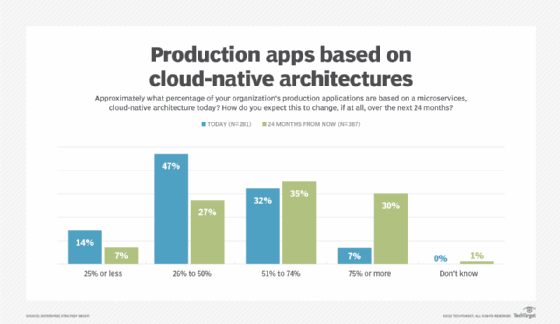Cloud-native modernization is on the rise (original) (raw)
Research suggests that cloud-native application deployment is becoming more prevalent as organizations continue to embrace public cloud infrastructure.
Enterprise Strategy Group hosted its four-part Distributed Cloud Series research project last year. The study consisted of four major sections as they pertain to distributed cloud: application infrastructure, cloud-native architecture and methodologies, observability from code to cloud, and impacts of edge on the digital ecosystem.
The 2022 findings are now available as syndicated research and can be found on the ESG Interactive Research Portal.
A look at the Distributed Cloud Series research
The 2023 Distributed Cloud Series research will kick off this fall. This series will consist of four parts that expand on research from the 2022 data sets, provide trend information on market direction, clarify the developer and DevOps buyer persona, and offer insights into the requirements that influence modern IT buying and decision-making.
In previous research, we found that cloud-native application strategies are becoming more common, in conjunction with ubiquitous public cloud usage. Nearly three-quarters of organizations currently developing cloud-native applications build and deploy those applications based on a microservices architecture.
The stats showed the following:
- Within two years, nearly two-thirds of organizations expect more than half of their production applications to be based on a microservices cloud-native architecture. Most organizations deploy production applications and server workloads on public cloud infrastructure and/or platform services. Currently, most organizations use more than one cloud infrastructure service provider. A majority of organizations indicated that application portability is, at the very least, critical or very important.
- IT recognizes the value of modern application architectures. Most organizations are adopting cloud-native applications, which run significantly faster than traditional applications. More than half of respondents indicated that cloud-native application development has had a very positive impact across several areas. These areas include deployment efficiency, earlier error identification and code review efficiency -- but challenges persist. More than one-third of respondents indicated that security is one of the biggest challenges their organization has faced or expects to face with its cloud-native applications.
- The path to cloud-native architecture is modern application platforms. The importance of developer-ready infrastructure was emphasized as very important or critical by nearly all respondents. Over the next two years, the primary technologies that organizations use for cloud-native applications are not expected to change much. Most indicated they use infrastructure as code (IaC) extensively or in a limited fashion. Of the organizations that are scaling their IaC implementations, more than half indicated they struggle to ensure quality and consistency across teams and/or safely make changes to infrastructure.
- The cloud-native transition is dependent on iterative methodologies. Most organizations leverage GitOps, DevOps and agile software methodologies in some capacity. More than half of organizations can typically deploy new code to production daily. Compared to their peer organizations, those extensive users of GitOps, DevOps and agile development methodologies were significantly more likely to deploy new code hourly.
- Organizational dynamics align to cloud-native success. Selecting the deployment location of cloud-native applications as well as the underlying application architecture relies on a cross-functional team approach. Paid, enterprise-level support is the preferred method when it comes to organizations' cloud-native ecosystems. Nearly all respondents indicated that they were influenced to purchase an enterprise agreement based on a vendor's participation in an open-source project. Many organizations plan to increase spending on technologies, services and personnel supporting cloud-native application development over the next 12-18 months. More than half said this is an action to optimize cloud-native application development strategies.

What comes next?
Let's unpack the cloud-native research for 2023. My colleague Scott Sinclair is planning to focus on ESG's "API-Driven Infrastructure Imperative" and the role of API-driven infrastructure, automation, IaC and AI-driven operations across distributed cloud environments. My colleague Rob Strechay is focusing on "Observability & Demystifying AIOps" and what that means to the state of observability, as well as specific AIOps use cases and requirements.
Our "Distributed Cloud Series 2023: The Mainstreaming of Cloud-native Applications & Methodologies" survey is focused on the state of DevOps/cloud-native apps and open source initiatives. We will be looking at insights into the impact of developer velocity and what it means to leverage a developer-ready infrastructure. The following are several other areas we will consider:
- cross-platform management and automation solutions;
- application and infrastructure portability;
- how teams identify application issues and execute remediation strategies;
- what tools organizations use to monitor cloud-native environments;
- how organizations prioritize incident response, forensics and compliance requirements;
- trending data that shows how businesses are prioritizing microservices and serverless application architectures; and
- containers and container management strategies.
Many organizations are well on their way to modernizing applications to stay competitive and meet the demands of customers. However, businesses are growing and evolving rapidly. The traditional application approaches may not be sufficient to meet the demands. Overall business success can be dependent on cloud-native approaches.
For organizations to modernize and evolve, ESG recommended taking the actions below.
Prepare development teams
Prepare development teams to build cloud-native applications on microservices architectures. As developers look at the existing architectures of traditional applications, it is important for these teams to deliver a scalable, unified strategy for a modern, cloud-first approach. Organizations leveraging microservices as part of their modernization efforts will not only deliver a scalable and elastic approach but also stay ahead with how production-based applications are deployed in the future.
Understand the distributed cloud approach for cloud-native deployments
Build cloud-native applications that are portable and flexible to run on multiple cloud service provider platforms. This ensures production applications will work on any cloud. Successful organizations deploy on many unique public cloud infrastructure service providers. Having a distributed or multi-cloud approach is important to cloud-native strategies.
Pay attention to portability
Remember that portability of cloud-native apps is an important factor, especially for organizations with hybrid strategies. Successful cloud-native organizations are viewing application portability to be a critical or very important factor. This includes the ability to move from the data center to the edge to the cloud, and from cloud to cloud as well. The reason is that organizations are deploying cloud-native applications in a combination of public cloud and private data centers.
Provide a developer-ready infrastructure
Appreciate how much the platform matters when deploying cloud-native applications. Providing a developer-ready infrastructure is highly recommended for cloud-native apps. Containers and serverless functions are, increasingly, areas organizations consider when deploying cloud-native applications.
Plan to use DevOps, agile software development and GitOps methodologies
Many organizations view themselves as mature when it comes to delivering new code. Most organizations can deploy new code to production daily. However, those organizations using iterative methodologies extensively are much likelier to do so hourly. This is a good indication of a strategy to emulate.
Ensure organizational dynamics align to cloud-native success
Organizations need to agree on cloud-native development. Multiple groups have an impact and influence on the decisions for deploying cloud-native applications. It is important to make sure the operations team and IT teams are on the same page about the business objectives.
Be mindful that cloud-native spending is increasing. Mainly, organizations are striving to drive cross-team collaboration. Plan to increase spending on technologies, services and personnel supporting cloud-native application development. Organizations should look to increase or improve collaboration across DevOps, app dev and IT operations teams. To learn more about this trending data, reach out and let's discuss how your organization can participate in this research.
ESG is a division of TechTarget.
Next Steps
How automating distributed cloud infrastructure changes IT
Takeaways and emerging trends from KubeCon Europe 2023
Compare cloud-native vs. cloud-based vs. cloud-enabled apps
A beginner's guide to cloud-native application development
 SAP S/4HANA vs. Oracle Cloud ERP: Which is best for you?
SAP S/4HANA vs. Oracle Cloud ERP: Which is best for you?  By: James Kofalt
By: James Kofalt  What is a cloud-native application?
What is a cloud-native application?  By: Kinza Yasar
By: Kinza Yasar  A beginner's guide to cloud-native application development
A beginner's guide to cloud-native application development  By: Zachary Flower
By: Zachary Flower  12-factor app
12-factor app  By: Margie Semilof
By: Margie Semilof